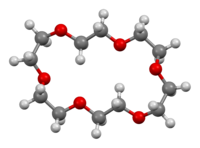18-crown-6
 |
|
 |
|
| Names | |
|---|---|
|
IUPAC name
1,4,7,10,13,16-hexaoxacyclooctadecane
|
|
| Identifiers | |
|
17455-13-9 |
|
| 3D model (Jmol) |
Interactive image Interactive image |
| ChEBI |
CHEBI:32397 |
| ChEMBL |
ChEMBL155204 |
| ChemSpider |
26563 |
| ECHA InfoCard | 100.037.687 |
| PubChem | 28557 |
|
|
|
|
| Properties | |
| C12H24O6 | |
| Molar mass | 264.315 g/mol |
| Density | 1.237 g/cm3 |
| Melting point | 37 to 40 °C (99 to 104 °F; 310 to 313 K) |
| Boiling point | 116 °C (241 °F; 389 K) (0.2 Torr) |
| Related compounds | |
|
Related compounds
|
Dibenzo-18-crown-6 Triglyme |
|
Except where otherwise noted, data are given for materials in their standard state (at 25 °C [77 °F], 100 kPa).
|
|
|
|
|
| Infobox references | |
18-Crown-6 is an organic compound with the formula [C2H4O]6 and the IUPAC name of 1,4,7,10,13,16-hexaoxacyclooctadecane. It is a white, hygroscopic crystalline solid with a low melting point. Like other crown ethers, 18-crown-6 functions as a ligand for some metal cations with a particular affinity for potassium cations (binding constant in methanol: 106 M−1). The point group of 18-crown-6 is S6. The dipole moment of 18-crown-6 varies in different solvent and under different temperature. Under 25 °C, the dipole moment of 18-crown-6 is 2.76 ± 0.06 D in cyclohexane and 2.73 ± 0.02 in benzene. The synthesis of the crown ethers led to the awarding of the Nobel Prize in Chemistry to Charles J. Pedersen.
This compound is prepared by a modified Williamson ether synthesis in the presence of a templating cation: It can be also prepared by the oligomerization of ethylene oxide:
It can be purified by distillation, where its tendency to supercool becomes evident. 18-Crown-6 can also be purified by recrystallisation from hot acetonitrile. It initially forms an insoluble solvate. Rigorously dry material can be made by dissolving the compound in THF followed by the addition of NaK to give [K(18-crown-6)]Na, an alkalide salt. Crystallographic analysis reveals a relatively flat molecule but one where the oxygen centres are not oriented in the idealized 6-fold symmetric geometry usually shown. The molecule undergoes significant conformational change upon complexation.
18-Crown-6 has a high affinity for the hydronium ion H3O+, as it can fit inside the crown ether. Thus, reaction of 18-crown-6 with strong acids gives the cation [H3O⊂18-crown-6]+. For example, interaction of 18-crown-6 with HCl gas in toluene with a little moisture gives an ionic liquid layer with the composition [H3O⊂18-crown-6]+[HCl2]−·3.8 C6H5Me, from which the solid [H3O⊂18-crown-6]+[HCl2]− can be isolated on standing. Reaction of the ionic liquid layer with two molar equivalents of water gives the crystalline product (H5O2)[H3O⊂18-crown-6]Cl2.
...
Wikipedia
